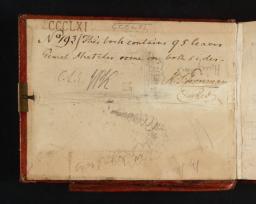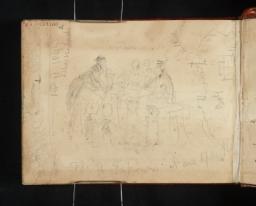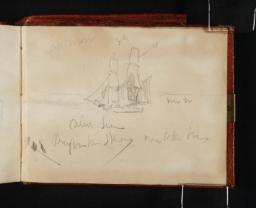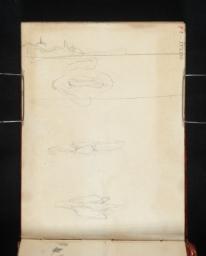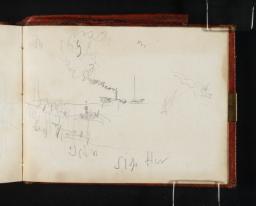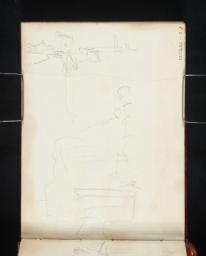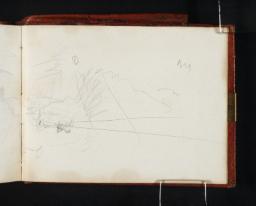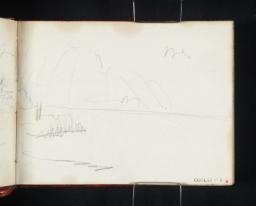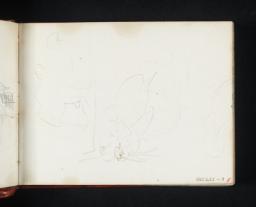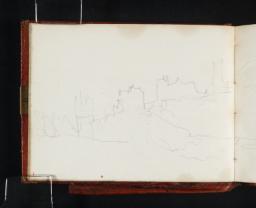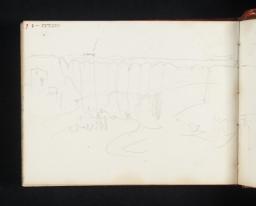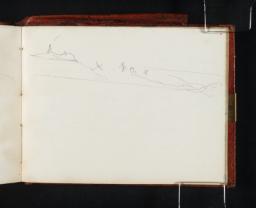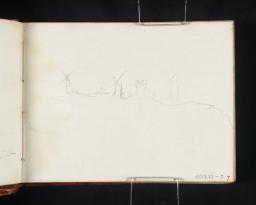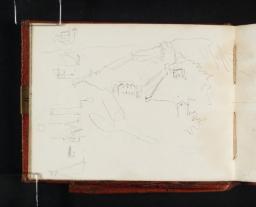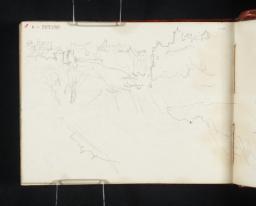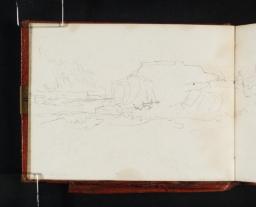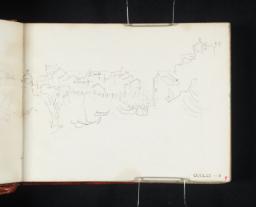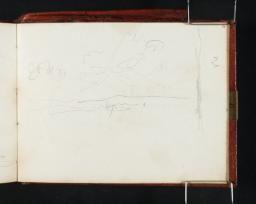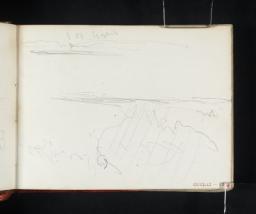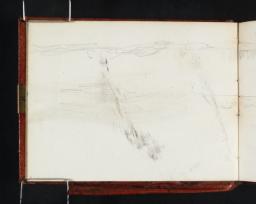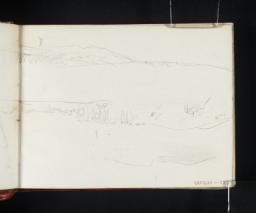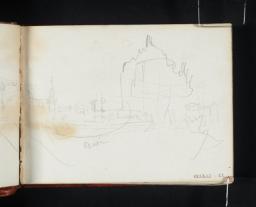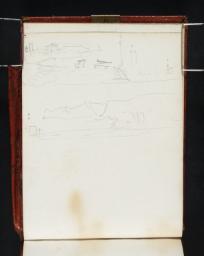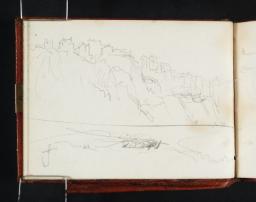Turner Bequest CCCLXI 1–108a
Sketchbook bound in boards covered in red-brown leather; leather pencil-holder loop to bottom edge of front cover; one brass clasp (missing)
108 leaves and paste-downs of white wove paper; page size 86 x 111 mm; page edges marbled in turquoise; watermark ‘W King | 1842’
Made by John Edward Spicer Mill, Alton, Hampshire
Numbered 193 as part of the Turner Schedule in 1854 and endorsed by the Executors of the Turner Bequest, inside front cover (D41150)
Blind-stamped with Turner Bequest monogram on front cover, towards top left
Stamped in black ‘CCCLXI’ on front cover, top right
Accepted by the nation as part of the Turner Bequest 1856
108 leaves and paste-downs of white wove paper; page size 86 x 111 mm; page edges marbled in turquoise; watermark ‘W King | 1842’
Made by John Edward Spicer Mill, Alton, Hampshire
Numbered 193 as part of the Turner Schedule in 1854 and endorsed by the Executors of the Turner Bequest, inside front cover (D41150)
Blind-stamped with Turner Bequest monogram on front cover, towards top left
Stamped in black ‘CCCLXI’ on front cover, top right
Accepted by the nation as part of the Turner Bequest 1856
Exhibition history
References
This sketchbook is one of three used by Turner on a brief visit to northern France in the autumn of 1845, as John Chu set out in the overall Introduction to the present tour. It is unusual in containing two specific notes of a full date, (Thursday) 11 September 1845, on folios 1 recto and 78 verso (D35487, D35625), from which Finberg inferred the year of its use, while the Normandy sketches at Eu, Tréport and Dieppe correlate with the colour studies in the two ‘roll’ sketchbooks associated with the tour, Eu and Tréport and Dieppe (Tate; Turner Bequest CCCLIX, CCCLX); Robert Upstone has noted: ‘Even at this late stage of his career Turner continued his traditional practice of using small books such as this in tandem with larger roll sketchbooks’.1 As David Blayney Brown has observed, the ‘correspondence noted by Finberg2 between pencil sketches in Dieppe and Kent, and subject treated in watercolour in the so-called ‘Ideas of Folkestone’ book [Tate; Turner Bequest CCCLVI], need not be coincidental, for Turner was still thinking pictorially, and gathering information for a purpose.’3
This is the last of the multitude of small pocket-books used by Turner for pencil sketching around Britain and Europe to be associated with a particular tour, which was his last to the Continent at the age of seventy; others were in use around this time, including the Channel sketchbook (Yale Center for British Art, New Haven), with pages dated ‘June 9’ and ‘July 24’4 among its pencil sketches and watercolour studies, and the Temeraire sketchbook (British Museum, London).5 The present book also includes views on the coast of Kent (see further notes below), perhaps made soon before or after the trip over the English Channel, and many very summary and effectively unidentifiable sketches of cliffs and coastal buildings, some apparently made while at sea6 (see the checklist at the end of this Introduction).
While the exact timing of Turner’s final overseas trip is uncertain, as Chu has summarised, it may have coincided with the flying visit by Queen Victoria and Prince Albert repaying the more public one made by Louis-Philippe, King of the French, to Britain in October 1844, as witnessed by Turner (see the ‘Louis-Philippe at Portsmouth 1844’ section of this catalogue). Returning from a Continental visit, the British royal party landed at Le Tréport on 8 September, as depicted in a copy by Princess Louise (1848–1939; Royal Collection) after Jean-Baptiste Isabey (1767–1855), staying overnight at the Château d’Eu before sailing to the Isle of Wight the next day.7
Sketches at Folkestone (see under folio 5 verso; D35496) and Boulogne (see under folio 1 recto; D35487) views may indicate Turner crossed between them at least one way, on a service introduced as recently as August 1843,8 while several views around Dover (see under folio 20 verso; D35523) might suggest the shortest route, to or from Calais, was also taken. Alternatively, various services had been introduced between Brighton, Newhaven and Shoreham in Sussex and Dieppe in Normandy.9
Turner evidently spent some time at leisure in Dieppe, as there are numerous studies of the harbour, seafront and castle (see under folio 31 recto; D35541). There are at least two views at Le Tréport, about twenty-miles up the coast to the north-east (see under folio 55 recto; 35583) and a couple of miles inland from there at Eu; Turner’s views of Louis-Philippe’s grand summer residence and the nearby Collegiate Church of Notre-Dame and Saint-Laurent are noted under folio 21 verso (D35525). He may have ventured a few miles further again, to the mouth of the Somme Estuary, as there are possible studies of the lighthouse at Le Hourdel on folios 54 recto and 61 verso (D35581, D35595). A rough map on folio 69 recto (D35609) includes Le Tréport, Eu, and the coast as far as the Baie de la Somme. He certainly travelled in that area, as there are two drawings of Abbeville, a little way into Picardy (see under folio 48 recto; D35571). A mere twelve miles from the Channel, this is the furthest he seemingly went inland on this last journey to the Europe he had first roamed in 1802, although a cryptic note on folio 25 recto (D35530) may include the word ‘Paris’, albeit crossed out.
Apart from Dover and Folkestone, mentioned above, the English subjects may include St Leonards-on-Sea in Sussex (folios 91 verso–29 recto; D35651–D35652) and possibly the Isle of Wight (folios 10 recto, 12 recto; D35505, D35509). There are various slight views of the Roman ruins at Richborough (see under folio 95 recto; D35658) and nearby Pegwell Bay (folios 103 verso, 108 recto (D35674, D35683). On the coast of eastern Kent, the latter are a few miles from Turner’s habitual base at Mrs Booth’s house in Margate (see under folio 99 verso; D35666). The studies of the sun and clouds over the sea on folios 105 recto–108 recto (D35677–D35783) and inside the back cover (D41151) were perhaps all made from there. Two (D35680, D35683) are dated 25 and 26 August. Among them, a sea study of a slightly different character (folio 108 verso; D35684) may relate to Turner’s late reworking of a much earlier painting as The Wreck Buoy (Walker Art Gallery, Liverpool),10 which he would exhibit in 1849.
There are typically convoluted financial notes on folio 102 recto (D35671), and casual studies of figures observed in outdoor settings on folios 1 recto, 55 verso–56 recto, 57 verso–58 recto and 90 verso (D35487, D35584–D35585, D35588–D35589, D35649). Less predictably, there are two pages with slight but explicit erotic sketches (folios 2 recto and 5 recto; D35489, D35495),11 while the drawing of an apparently empty bed on folio 78 verso (D35625) might have served to recall a personal encounter of some kind. Ian Warrell has effectively dismissed the idea that John Ruskin might have seen and been shocked by these private and inconspicuous drawings soon after they were made.12 In any event, Finberg noted Ruskin’s endorsement on a wrapper in the course of preliminary cataloguing work on the Turner Bequest: ‘Inv. 193. Nearly valueless. Scrawls at Dieppe.’13
An unusually large number of the drawings here are as yet unidentified, being slight and sometimes scrappy studies of the sea, harbours, cliffs, skies, and shipping. Interspersed with identified views, most of the coastal scenes and the few landscapes appear more likely to in France; when ‘Channel’ has been included in their titles it is without the customary ‘English’ prefix, to avoid the implication that they are necessarily subjects on that side rather than the French. A few share page with identified views. They are all listed here without further comment:
inside front cover (D41150), folios 1 recto–4 verso, 6 verso–9 verso, 10 verso–11 verso, 13 verso, 15 verso–18 recto, 20 recto, 22 recto, 23 verso, 24 recto, 26 verso–27 verso, 29 recto, 30 recto, 32 verso, 33 verso, 34 recto, 35 verso, 36 recto, 38 recto, 40 recto and verso, 41 verso, 42 recto, 46 verso , 48 verso–52 recto, 54 verso, 60 verso, 62 recto, 64 verso, 65 recto, 66 recto, 67 verso, 68 recto, 70 verso, 71 recto, 73 verso–74 recto, 75 verso–78 recto, 79 recto and verso, 80 verso–83 verso, 86 recto and verso, 87 verso, 88 recto–90 recto, 91 recto–92 recto, 95 verso–97 verso, 99 recto, 102 verso, 107 verso (D35487–D35494, D35498–D35504, D35506–D35508, D35510, D35515–D35520, D35522, D35526, D35527, D35529, D35533–D35535, D35537, D35539, D35544, D35546, D35547, D35550, D35551, D35554, D35557, D35558, D35560, D35561, D35568, D35572, D35574–D35579, D35582, D35594, D35597, D35602–D35605, D35607, D35612, D35613, D35615, D35617, D35619–D35624, D35626, D35627, D35629–D35635, D35640–D35642, D3564–D35648, D35650–D35652, D35659–D35663, D35665, D35672, D35682)
See Wilton 1986, pp.10, 12; the Channel book is dated to ‘June–September 1845’ in Ian Warrell, Turner’s Sketchbooks, London 2014, p.224.
See Guillaud 1981, p.563, Wilton 1983, p.304, Wilton 1986, p.9, Wilton 1987, p.244, Herrmann 1990, p.251, Warrell 2003, p.43 and Wilton 2006, p.243.
See the detailed caption to the copy, Royal Collection Trust, accessed 7 March 2016, https://www.royalcollection.org.uk/collection/980002/the-queen-landing-in-france-sept-8th-1845 .
See ‘History of Folkestone Harbour and Cross Channel Links’, Folkestone Harbour Company, accessed 23 September 2016, http://folkestoneharbour.com/pages/history.html .
See John Willett and others, The Dieppe Connection: The Town and its Artists from Turner to Braque, exhibition catalogue, Brighton Museum and Art Gallery 1992, pp.[9], [84], 85.
Technical notes
How to cite
Matthew Imms, ‘Dieppe and Kent sketchbook 1845’, sketchbook, September 2016, in David Blayney Brown (ed.), J.M.W. Turner: Sketchbooks, Drawings and Watercolours, Tate Research Publication, December 2016, https://www

